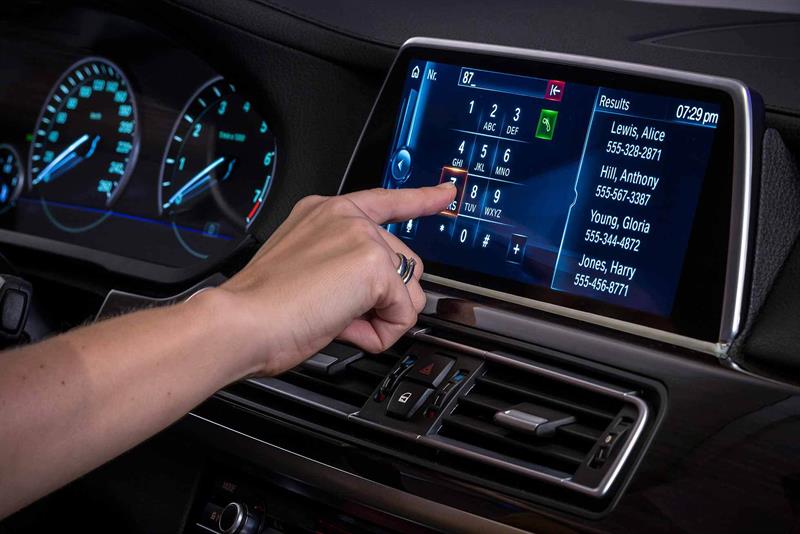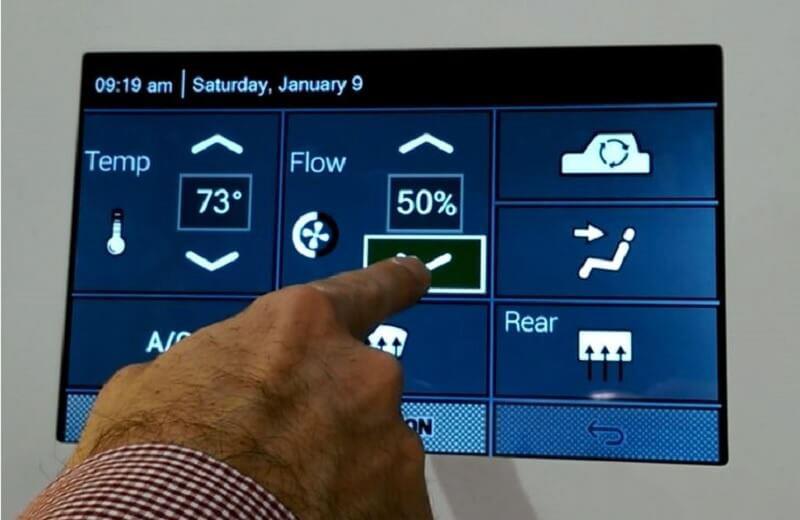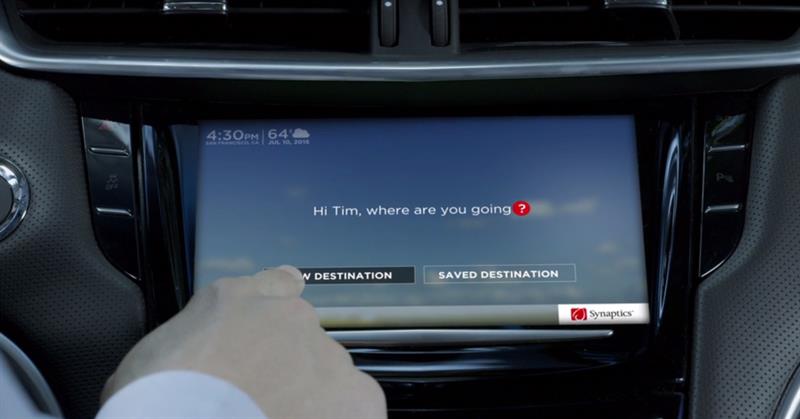The relatively recent adoption of fast, bright, and responsive capacitive sensing by the automotive industry is a response to the demands of the ‘iPhone generation’: car owners will no longer accept that the touchscreen in their €30,000 car may be worse than that of a smartphone costing just €500 or less.
But for various reasons, car manufacturers will not simply replicate the touchscreen form factors and designs that have been implemented in the smartphone. As we shall see, through experimentation and differentiation automotive manufacturers could realise a touchscreen which matches the ease of use of smartphones, and which also complies with the rigorous automotive requirements for safety and reliability.
The essence of the smartphone experience
The standard of user experience that today’s smartphone touchscreen sets is extraordinarily high. Consumers love the smartphone’s touchscreen because it is:
• fast, responsive, and sensitive to the lightest touch
• intuitive – the functions, such as swiping, button presses, zooming, scrolling and rotating, can all be implemented with simple and obvious touches and gestures
• bright, colourful and attractive to look at
These are features of capacitive sensing technology; the now outdated resistive sensing technology – many cars on the road today have resistive-sensing touchscreens – does not provide them. Old-style resistive sensing touchscreens are inferior because:
• the technology cannot detect the location of more than one finger at one time
• the touchscreen requires a firm press, which makes it feel less responsive and slower than a capacitive sensing screen. And it’s simply less pleasurable to use.
• the resistive screen’s sensor layers decrease the transmittance of the display, decreasing the brightness and rendering it less sharp than a display with a capacitive touchscreen
Capacitive touch sensing is, then, a preferable technology for the automotive user interface (UI). But the CID is a different use case from the mobile phone: this is for reasons of safety, the user experience, and user preferences. 
Fig. 1: modern cars’ touchscreen displays use large icons for ease of use at arm’s length. This example is BMW’s iDrive. (Photo credit: Synaptics)
Safety considerations oblige car makers to configure the UI so that the driver spends as little time as possible with his or her eyes away from the road. Among other things, this calls for the use of much larger icons than a mobile phone’s display uses (see Figure 1). At the same time, the CID is at a slightly greater distance from the user’s eyes – almost arm’s length – than a mobile phone typically is when in use. To make the content on the screen easier to view, and also to accommodate large icons, the size of the next-generation automotive touchscreen therefore needs to be bigger. Car manufacturers today are generally developing CIDs of 7”, 8”, 9” or 10” diagonal size. And this accords with user preference: just as with TVs, tablets and phablets, consumers opt for larger and larger displays over time, given the choice.
So a new generation of larger capacitive touchscreens will make cars both safer and more desirable. The new, larger form factors will also, however, give automotive manufacturers a new set of challenges in ensuring that their capacitive touchscreen implementations are both reliable and robust. Synaptics’ experience in helping customers implement capacitive touchscreens in tablet-size form factors suggests that there will be broadly four issues that manufacturers will need to take into account.
1. Noise and interference
A capacitive touchscreen works by sensing the capacitance across a grid of electrodes – very fine trace wires – below the ‘cover lens’ (the transparent glass or polycarbonate top layer of the display assembly). An unwanted secondary function of this array of electrodes is that it acts as an antenna, which picks up interference from the many sources of electro-magnetic noise in a car, such as electric motors, the starter coil, and Bluetooth®, GPS and other radios. The automotive environment is, in fact, far more noisy than typical home or office environments in which consumer tablets with 7-10” touchscreens are used.
The larger the display, the bigger the ‘antenna’ formed by the electrodes, and so the more noise is coupled to the touchscreen controller IC. This noise has the potential to catastrophically disrupt touch operations, with the risk of producing ghost touches (the system thinks the user has touched the screen when they have not) and failed touches (the system fails to acknowledge a valid touch).
Different touchscreen solutions address the problem of noise in different ways; some trade off noise immunity against performance. Touchscreen solutions from Synaptics avoid any such trade-offs, instead implementing high-grade noise filtering schemes to keep the effect of noise below a safe threshold.
In fact, Synaptics touch controllers feature a hybrid sensing scheme which implements both ‘self-capacitance’ and ‘mutual capacitance’ sensing simultaneously. This provides for excellent performance: the self-capacitance method is highly sensitive to changes in capacitance, giving the screen a highly responsive feel to the user and enabling proximity sensing; the mutual capacitance method supports multi-touch functions.
On its own, the self-capacitance method is also particularly sensitive to noise, as well as to background capacitance. By combining self- and mutual capacitance, the controller IC can implement noise filtering in both hardware and firmware, and ensure that noise is eliminated from the computations which convert raw measurements of capacitance into recognised touch events.
Separately, the touchscreen system design also affects its noise immunity – such factors as the material and thickness of the cover lens, for instance, are important. Here, the support and guidance of an experienced touchscreen solutions provider can help the CID manufacturer to optimise its design choices. Synaptics also provides a highly flexible simulation tool, SafeSense, which allows the user to experiment with different configurations of cover lens material, thickness, and sensor patterns to simulate the system’s immunity to noise under various scenarios.
2. Enhancements to the user experience
In a mobile phone, the user is expected to focus their whole attention on the device when operating the touchscreen. In a car, the user’s attention should be almost entirely on the road – not on the touchscreen.
This is why a car’s touchscreen display requires the use of large icons, which are easier to locate with the finger with a quick glance. But two enhancements to the touchscreen can help the user operate the touchscreen without looking at it:
• force sensing prevents the screen from registering inadvertent touches, which are both irritating to the user and cause unnecessary additional distraction as the driver has to cancel the selected operation and go back up the menu. An additional benefit is that the on-screen controls can be incrementally adjusted in response to the force of the user’s touch (see Figure 2). In changing the volume of the sound system, for instance, the touchscreen might adjust it faster when the Volume Up/Volume Down button is pressed hard, and more gradually when it is pressed gently.
• haptics, a type of tactile feedback, can signal to the user that a button is being actuated without the user needing to look at the screen, providing a pulse or vibration, for instance, in response to a button press. Tactile feedback can be supplemented by simultaneous sounds that signal the recognition of specific touch events. Fig. 2: a Synaptics demonstration of a capacitive touchscreen with force-sensing capability. (Photo credit: Synaptics)
Fig. 2: a Synaptics demonstration of a capacitive touchscreen with force-sensing capability. (Photo credit: Synaptics)
The combination of force sensing and haptics provides an intuitive user experience which distracts the driver less than a conventional touch-only system does. This provides for safer driving. It also makes the experience of using the touchscreen more enjoyable and intuitive.
(Synaptics demonstrated an automotive-grade touchscreen solution with force-sensing and haptics at the Consumer Electronics Show in January 2016.)
3. Differentiated styling choices
A car’s cabin provides far greater scope for differentiated styling of a display than does a portable tablet or smartphone form factor. The look and feel of the display is part of the car’s design, helping to differentiate it and create consumer appeal that users will pay a premium for.
The console that the CID sits in is itself, of course, a design unique to the vehicle. The touchscreen can also be customised through the choice and design of the cover lens. The choice of cover lens materials – glass or polycarbonate – makes a difference both to the look and the performance of the system.
In addition, car manufacturers have the ability to match the shape of the touchscreen’s surface to the console. For instance, if the console is slightly curved inward towards the driver, the surface of the cover lens can have a matching curve. This means the cover lens will be thicker at the sides than in the middle.
Standard touchscreen controllers are configured to operate with a cover lens of a uniform thickness. The Design Studio tuning tools which support Synaptics controller ICs enable the response of the touch controller IC to be optimised for the thickness of the cover lens.
It’s interesting to note that, in successfully implementing a curved touchscreen display, automotive manufacturers will be going beyond the state-of-the-art achieved by smartphone and tablet manufacturers.
Fig. 3: haptic feedback enhances the user experience by acknowledging a touch event without requiring the user’s eyes to be on the screen, as in this demonstration by Synaptics. (Photo credit: Synaptics)
4. Production stability
Having simulated various design options and verified the performance and noise immunity of the design, the manufacturer will take the design into mass production. It is essential that every manufactured unit performs as intended – but elements of the assembly are subject to inherent manufacturing variations. In particular, variations in thickness between one cover lens unit and another are commonplace. So too is variation in the resistance of production units of the ITO electrode layer. Both these variations have the potential to affect the touchscreen’s sensitivity and accuracy.
For users of Synaptics touchscreen solutions, the SafeSense tool provides for comprehensive simulation of the variability in production units, including Monte Carlo statistical simulations to model the maximum extent of variation in the capacitance values that the touchscreen controller will experience. The DesignStudio tool also provides tuning wizards which allow manufacturers to optimise the controller's configuration across the variability in cover lens thickness, ITO layer resistance and other properties of the touchscreen assembly.
Conclusion
The car industry’s UI designers are experiencing exciting times, since the adoption of capacitive sensing touchscreen technology hugely enhances the functionality of the UI, and makes the user experience much more enjoyable. As this article shows, however, the process of implementing capacitive touchscreens in the car will not straightforwardly follow the same path as the smartphone. Paying due attention to the four technical design issues identified in this article will help automotive manufacturers to achieve a successful, high-performance implementation of this proven technology with the fewest possible design iterations.
Author profile:
John Brady is senior director (Automotive) at Synaptics













